Requirements:
- Tire sealant bottle
- TIREFIT sticker
- Tire inflation compressor
- Gloves (depending on the vehicle equipment)
TIREFIT kit storage location:
You can use TIREFIT tire sealant to seal perforation
damage of up to 0.16 in (4 mm), particularly
those in the tire contact surface. You can use
TIREFIT in outside temperatures down to -4 ºF
(-20 ºC).
| WARNING Risk of accident when using
tire sealant. |
In the following situations, the tire sealant is
unable to provide sufficient breakdown assistance,
as it is unable to seal the tire properly:
- There are cuts or punctures in the tire
larger than those previously mentioned.
- The wheel rim is damaged.
- You have driven at a very low tire pressure
or on a flat tire.
- Do not continue driving.
- Consult a qualified specialist workshop.
|
| WARNING Risk of injury and poisoning
from tire sealant |
| The tire sealant is harmful and causes irritation.
Do not allow it to come into contact
with the skin, eyes or clothing, and do not
swallow it. Do not inhale tire sealant fumes.
Keep the tire sealant away from children.
If you come into contact with the tire sealant,
observe the following:
- Rinse off the tire sealant from your skin
immediately using water.
- If tire sealant gets into your eyes, thoroughly
rinse out the eyes using clean
water.
- If tire sealant has been swallowed,
immediately rinse out the mouth thoroughly
and drink plenty of water. Do not
induce vomiting and seek medical
attention immediately.
- Change out of any clothes contaminated
with tire sealant immediately.
- If allergic reactions occur, seek medical
attention immediately.
|
| NOTE Overheating due to the tire inflation
compressor running too long |
- Do not run the tire inflation compressor
for longer than ten minutes without
interruption.
|
Comply with the manufacturer's safety notes on
the sticker on the tire inflation compressor.
Have the tire sealant bottle replaced at a qualified
specialist workshop every five years.
- Do not remove any foreign objects which
have entered the tire.
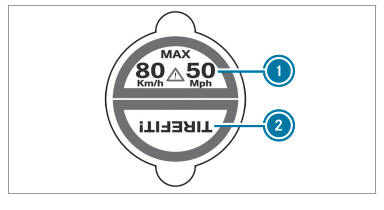
- Affix part 1 of the TIREFIT sticker to the
instrument cluster within the driver's field of
vision.
- Affix part 2 of the TIREFIT sticker near the
valve on the wheel with the faulty tire.
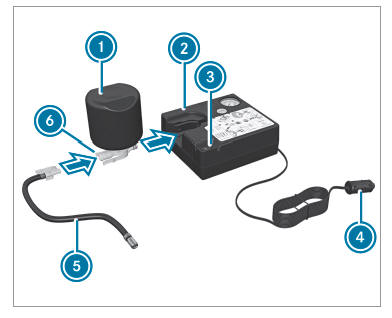
- Pull plug 4 with the cable and hose 5 out
of the tire inflation compressor housing.
- Push the plug of hose 5 into flange 6 of
tire sealant bottle 1 until the plug engages.
- Place tire sealant bottle 1 head downwards
into recess 2 of the tire inflation compressor.
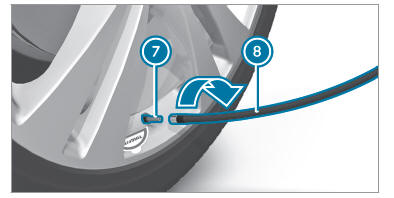
- Remove the cap from valve 7 on the faulty
tire.
- Screw filling hose 8 onto valve 7.
- Insert plug 4 into a 12 V socket in your
vehicle.
- Switch on the ignition.
- Press on and off switch 3 on the tire inflation
compressor.
The tire inflation compressor is switched on.
The tire is inflated. First, tire sealant is pumped
into the tire. The pressure may briefly
rise to approximately 500 kPa (5 bar/73 psi).
Do not switch off the tire inflation compressor
during this phase.
If tire sealant leaks out, make sure you clean the
affected area as quickly as possible. It is preferable
to use clear water.
If you get tire sealant on your clothing, have it
cleaned as soon as possible with perchloroethylene.
If, after ten minutes, a tire pressure of
200 kPa (2.0 bar/29 psi) has not been achieved:
- Switch off the tire inflation compressor.
- Unscrew the filling hose from the valve of the
faulty tire.
Please note that tire sealant may leak out when
unscrewing the filling hose.
| WARNING Risk of accident due to the
specified tire pressure not being reached |
| If the specified tire pressure is not reached
after the specified time, the tire is too badly
damaged. The tire sealant cannot repair the
tire in this instance.
Damaged tires and a tire pressure that is too
low can significantly impair braking and handling
characteristics.
- Do not continue driving.
- Consult a qualified specialist workshop.
|
If, after ten minutes, a tire pressure of
200 kPa (2.0 bar/29 psi) has been achieved:
| WARNING Risk of accident from driving
with sealed tires |
A tire temporarily sealed with tire sealant
impairs driving characteristics and is not
suitable for higher speeds.
- Adapt your driving style accordingly and
drive carefully.
- Do not exceed the maximum speed
limit with a tire that has been repaired
using tire sealant.
|
- Observe the maximum permissible speed for
a tire sealed with tire sealant 50 mph
(80 km/h).
- Affix the upper section of the TIREFIT sticker
to the instrument cluster in a location where
it will be easily seen by the driver.
| NOTE Staining caused by leaking tire
sealant |
After use, excess tire sealant may leak out
from the filling hose.
- Therefore, place the filling hose in the
plastic bag that contained the TIREFIT
kit.
|
| ENVIRONMENTAL NOTE Environmental
pollution caused by environmentally irresponsible
disposal |
Tire sealant contains pollutants.
- Have the tire sealant bottle disposed of
professionally, e.g. at an authorized
Mercedes-Benz Center.
|
| WARNING Risk of accident due to the
specified tire pressure not being reached |
| If the specified tire pressure is not reached
after a brief drive, the tire is too badly damaged.
The tire sealant cannot repair the tire
in this instance.
Damaged tires and tire pressure that is too
low can significantly impair the braking properties
and the handling characteristics.
- Do not continue driving.
- Consult a qualified specialist workshop.
|
In cases such as the one mentioned above, contact
an authorized Mercedes-Benz Center. Or
call 1-800-FOR-MERCedes (in the USA) or
1-800-387-0100 (in Canada).
- Correct the tire pressure if it is still at least
130 kPa (1.3 bar/19 psi). See the Tire and
Loading Information placard on the driver's
side B‑pillar or the tire pressure table in the
fuel filler flap for values.
- To increase the tire pressure: switch on
the tire inflation compressor.
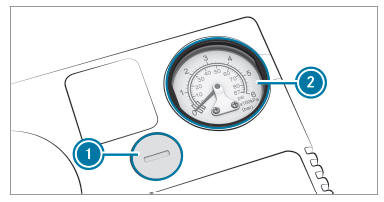
- To reduce the tire pressure: press pressure
release button 1 next to pressure gauge
2.
- When the tire pressure is correct, unscrew
the filling hose from the valve of the sealed
tire.
- Screw the valve cap onto the valve of the
sealed tire.
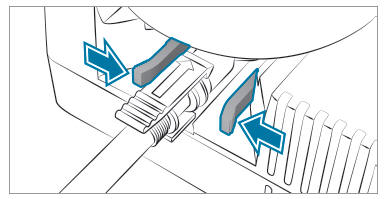
|







